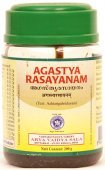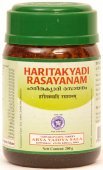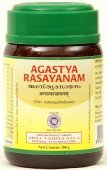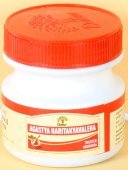Apamarga, Apāmārga, Apamārga: 23 definitions
Introduction:
Apamarga means something in Hinduism, Sanskrit, Marathi, biology. If you want to know the exact meaning, history, etymology or English translation of this term then check out the descriptions on this page. Add your comment or reference to a book if you want to contribute to this summary article.
In Hinduism
Ayurveda (science of life)
Cikitsa (natural therapy and treatment for medical conditions)
Source: Wisdom Library: Ayurveda: CikitsaApāmārga (अपामार्ग) is a Sanskrit word referring to the “rough chaff tree”, a species of plant from the Amaranthaceae (Amaranth) family, and is used throughout Ayurvedic literature such as the Caraka-saṃhitā. The official botanical name of the plant is Achyranthes aspera and is known in English as the “chaff-flower” or “devil’s horsewhip”. The word Apāmārga is derived from the Sanskrit root √mṛj, meaning “to whipe” or “to wash”.
The plant Apāmārga is also mentioned as a medicine used for the treatment of all major fevers, as described in the Jvaracikitsā (or “the treatment of fever”) which forms the first chapter of the Sanskrit work called Mādhavacikitsā.
Rasashastra (Alchemy and Herbo-Mineral preparations)
Source: Wisdom Library: Rasa-śāstraApāmārga (अपामार्ग).—The name of a plant, possibly identified with Achyranthes aspera. It is used in various alchemical processess related to mercury (rasa or liṅga), according to the Rasārṇavakalpa (11th-century work dealing with Rasaśāstra).
Nighantu (Synonyms and Characteristics of Drugs and technical terms)
Source: WorldCat: Rāj nighaṇṭuApāmārga (अपामार्ग) is the Sanskrit name for a medicinal plant identified with Achyranthes aspera Linn. (“prickly chaff-flower”) from the Amaranthaceae or “amaranth” family of flowering plants, according to verse 4.88-91 of the 13th-century Raj Nighantu or Rājanighaṇṭu. Apāmārga is known in the Hindi language as Circiṭā, Cicaḍā or Laṭjirā; in the Bengali language as Apāṅga; in the Marathi language as Aghadha; in the Gujarati language as Agheḍo; in the Tamil language as Nayurivi; and in the Telugu language as Apāmārgam.
Apāmārga is mentioned as having twenty-two synonyms: Śikharī, Kiṇihī, Kharamañjarī, Durgraha, Adhaḥśalya, Pratyakpuṣpī, Mayūraka, Kāṇḍakaṇṭa, Śaikharika, Markaṭī, Durabhigraha, Vaśira, Parākpuṣpī, Kaṇṭī, Markaṭapippalī, Kaṭu, Māñjarika, Nandī, Kṣayaka, Paṅktikaṇṭaka, Mālākaṇṭaka and Kubja.
Properties and characteristics: “Apāmārga is pungent, bitter and hot. It quells vitiated kapha. It is indicated in piles, pruritis, improper digestive metabolism (āma-doṣa), abdominal disorders (udar-roga), blood disorders. It is astringent and emetic”.
Kalpa (Formulas, Drug prescriptions and other Medicinal preparations)
Source: Shodhganga: Edition translation and critical study of yogasarasamgrahaApāmārga (अपामार्ग) refers to the medicinal plant known as “Achyranthes aspera Linn.” and is dealt with in the 15th-century Yogasārasaṅgraha (Yogasara-saṅgraha) by Vāsudeva: an unpublished Keralite work representing an Ayurvedic compendium of medicinal recipes. The Yogasārasaṃgraha [mentioning apāmārga] deals with entire recipes in the route of administration, and thus deals with the knowledge of pharmacy (bhaiṣajya-kalpanā) which is a branch of pharmacology (dravyaguṇa).
Toxicology (Study and Treatment of poison)
Source: Shodhganga: Kasyapa Samhita—Text on Visha ChikitsaApāmārga (अपामार्ग) is the name of an ingredient used in the treatment of Rājilā-snake-bites, according to the Kāśyapa Saṃhitā: an ancient Sanskrit text from the Pāñcarātra tradition dealing with both Tantra and Viṣacikitsā—an important topic from Āyurveda which deals with the study of Toxicology (Viṣavidyā or Sarpavidyā).—The tenth Adhyāya prescribes antidotes for Rājilā snake venom.—According to the Kāśyapasaṃhitā verse X.2cd: “The first antidote prescribed is añjana or (paste) are application to the body and nasya (nasal drops) made by mixing the sprouts of Ginger, Bilva, Apāmārga, ripe Bṛhatī fruit, a pod of Śālmalī seed shell. This ointment cum nasal application is very potent and revive the dead person”.

Āyurveda (आयुर्वेद, ayurveda) is a branch of Indian science dealing with medicine, herbalism, taxology, anatomy, surgery, alchemy and related topics. Traditional practice of Āyurveda in ancient India dates back to at least the first millenium BC. Literature is commonly written in Sanskrit using various poetic metres.
Purana and Itihasa (epic history)
Source: archive.org: Shiva Purana - English TranslationApāmārga (अपामार्ग) is the name of a flower used in the worship of Śiva, according to the Śivapurāṇa 2.1.11:—“[...] offerings of flowers, especially white flowers and rare flowers, shall be made to Lord Śiva. Flowers of Apāmārga, Karpūra, Jātī, Campaka, Kuśa, Pāṭala, Karavīra, Mallikā, Kamala (lotus) and Utpalas (lilies) of various sorts shall be used. When water is poured it shall be poured in a continuous stream”.
Source: Shodhganga: The saurapurana - a critical studyApāmārga (अपामार्ग) wood is used for brushing the teeth in the month Phālguna for the Anaṅgatrayodaśī-Vrata, according to the 10th century Saurapurāṇa: one of the various Upapurāṇas depicting Śaivism.—Accordingly, the Anaṅgatrayodaśī-vrata is observed in honour of Śiva for acquiring virtue, great fortune, wealth and for destruction of sins [...] This vrata is to be performed for a year from Mārgaśīra.—In the month of Phālguna, the tooth-brush is that of apāmārga-wood. The food taken is kaṅkola. The deity to be worshipped is Vīra. The flowers used in worship are kunda. The naivedya offerings are sweet meats. The result accrued is gomedha.

The Purana (पुराण, purāṇas) refers to Sanskrit literature preserving ancient India’s vast cultural history, including historical legends, religious ceremonies, various arts and sciences. The eighteen mahapuranas total over 400,000 shlokas (metrical couplets) and date to at least several centuries BCE.
Shaivism (Shaiva philosophy)
Source: Shodhganga: The saurapurana - a critical study (shaivism)Apāmārga (अपामार्ग) refers to one of the various leaves and flowers used in the worship of Śiva, according to the 10th century Saurapurāṇa: one of the various Upapurāṇas depicting Śaivism.—The text refers the following flowers and leaves to be offered to Lord Śiva [viz., Apāmārga][...]. It is stated that if a person offers these flowers to Lord Śiva, planting himself, the Lord Himself receives those flowers.

Shaiva (शैव, śaiva) or Shaivism (śaivism) represents a tradition of Hinduism worshiping Shiva as the supreme being. Closely related to Shaktism, Shaiva literature includes a range of scriptures, including Tantras, while the root of this tradition may be traced back to the ancient Vedas.
Jyotisha (astronomy and astrology)
Source: Google Books: Studies in the History of the Exact Sciences (Astronomy)Apāmārga (अपामार्ग) refers to one of the items offered to the nine planets (navagraha), according to the grahaśānti (cf. grahayajña) section of the Yājñavalkyasmṛti (1.295-309), preceded by the section called vināyakakalpa (1.271-294), prescribing a rite to be offered to Vināyaka.—[verse 302-303: Faggots to be burned]—These two verses prescribe different faggots to be burned for grahas with offerings of honey, ghee, dadhi, and milk. It is interesting to note that some of the faggots (i.e. parāśa, khadira, pippala, and śamī) mentioned here are also used in the Suśrutasaṃhitā in the context (Uttaratantra chapters 27-37) of curing the diseases caused by grahas, which, in this case, are not planetary. [verse 304-305: Cooked rice (odana) to be offered to grahas]

Jyotisha (ज्योतिष, jyotiṣa or jyotish) refers to ‘astronomy’ or “Vedic astrology” and represents the fifth of the six Vedangas (additional sciences to be studied along with the Vedas). Jyotisha concerns itself with the study and prediction of the movements of celestial bodies, in order to calculate the auspicious time for rituals and ceremonies.
Biology (plants and animals)
Source: Wisdom Library: Local Names of Plants and DrugsApamarga in the Assamese language is the name of a plant identified with Achyranthes bidentata Blume from the Amaranthaceae (Amaranth) family having the following synonyms: Achyranthes hispida, Achyranthes japonica, Achyranthes chinensis. For the possible medicinal usage of apamarga, you can check this page for potential sources and references, although be aware that any some or none of the side-effects may not be mentioned here, wether they be harmful or beneficial to health.
Apamarga in the Sanskrit language, ibid. previous identification.
Apamarga [অপামার্গ] in the Bengali language is the name of a plant identified with Achyranthes aspera L. from the Amaranthaceae (Amaranth) family.
Apamarga [અપામાર્ગ] in the Gujarati language, ibid. previous identification.
Apamarga [अपामार्ग] in the Hindi language, ibid. previous identification.
Apamarga [अपामार्ग] in the Marathi language, ibid. previous identification.
Apamarga [ଅପାମାର୍ଗ] in the Odia language, ibid. previous identification.
Apamarga [अपामार्ग] in the Sanskrit language, ibid. previous identification.
Source: Google Books: CRC World Dictionary (Regional names)1) Apamarga in India is the name of a plant defined with Achyranthes aspera in various botanical sources. This page contains potential references in Ayurveda, modern medicine, and other folk traditions or local practices It has the synonym Centrostachys indica (L.) Standl. (among others).
2) Apamarga is also identified with Achyranthes bidentata It has the synonym Achyranthes mauritiana Moq..
Example references for further research on medicinal uses or toxicity (see latin names for full list):
· The India Journal of Experimental Biology (IJEB) (1977)
· Opera Botanica (1993)
· Tropical Plant Science Research. New Delhi (1983)
· Journal of the Washington Academy of Sciences (1915)
· Journal of Ethnopharmacology (1982)
· Journal of Shandong College of Traditional Chinese Medicine (1988)
If you are looking for specific details regarding Apamarga, for example diet and recipes, chemical composition, health benefits, side effects, pregnancy safety, extract dosage, have a look at these references.

This sections includes definitions from the five kingdoms of living things: Animals, Plants, Fungi, Protists and Monera. It will include both the official binomial nomenclature (scientific names usually in Latin) as well as regional spellings and variants.
Languages of India and abroad
Marathi-English dictionary
Source: DDSA: The Molesworth Marathi and English Dictionaryapāmārga (अपामार्ग).—m (S) A plant, Achyranthes aspera. The ashes (apāmārgakṣāra m) are used in washing clothes.
Marathi is an Indo-European language having over 70 million native speakers people in (predominantly) Maharashtra India. Marathi, like many other Indo-Aryan languages, evolved from early forms of Prakrit, which itself is a subset of Sanskrit, one of the most ancient languages of the world.
Sanskrit dictionary
Source: DDSA: The practical Sanskrit-English dictionaryApamārga (अपमार्ग).—
1) A by-path, side-way; a bad way.
2) Shampooing, rubbing &c. of the body (aṅgaparimārjanam) अमृतद्रवैर्विदधदब्जदृशामपमार्गमोषधिपतिः स्म करैः (amṛtadravairvidadhadabjadṛśāmapamārgamoṣadhipatiḥ sma karaiḥ) Śiśupālavadha 9.36.
Derivable forms: apamārgaḥ (अपमार्गः).
--- OR ---
Apāmārga (अपामार्ग).—[apamṛjyate vyādhyādiranena ityapāmārgaḥ, mṛj karaṇe ghañ kutvaṃ dīrghaśca P III.3.121. Sk.] Name of a plant Achyranthes Aspera (Mar. āghāḍā) largely used in medicine, washing teeth, sacrificial and other religious purposes and in incantations; अपामार्ग त्वया वयं सर्वं तदपमृज्महे (apāmārga tvayā vayaṃ sarvaṃ tadapamṛjmahe); अपामार्ग ओषधीनां सर्वासामेक इद्वशी (apāmārga oṣadhīnāṃ sarvāsāmeka idvaśī) | Av.
Derivable forms: apāmārgaḥ (अपामार्गः).
Source: Cologne Digital Sanskrit Dictionaries: Shabda-Sagara Sanskrit-English DictionaryApāmārga (अपामार्ग).—m.
(-rgaḥ) A plant, (Achyranthes aspera.) E. apa, mṛja to clean, with āṅ prefixed, and ghañ affix; the ashes are used in washing linen.
Source: Cologne Digital Sanskrit Dictionaries: Benfey Sanskrit-English DictionaryApamārga (अपमार्ग).—i. e. I. apa-mṛj + a, m. Cleansing, [Śiśupālavadha] 9, 36. Ii. apa -mārga, m. A sideway, [Pañcatantra] 169, 15.
Source: Cologne Digital Sanskrit Dictionaries: Cappeller Sanskrit-English DictionaryApamārga (अपमार्ग).—1. [masculine] by-road, side-way.
--- OR ---
Apamārga (अपमार्ग).—2. [masculine] wiping off, cleaning.
Source: Cologne Digital Sanskrit Dictionaries: Monier-Williams Sanskrit-English Dictionary1) Apamārga (अपमार्ग):—[=apa-mārga] 1. apa-mārga m. a by-way, [Pañcatantra]
2) [=apa-mārga] [from apa-mṛj] 2. apa-mārga m. wiping off, cleaning, [Śiśupāla-vadha]
3) Apāmārga (अपामार्ग):—[=apā-mārga] m. (√mṛj), the plant Achyranthes Aspera (employed very often in incantations, in medicine, in washing linen, and in sacrifices), [Atharva-veda; Vājasaneyi-saṃhitā etc.]
Source: Cologne Digital Sanskrit Dictionaries: Goldstücker Sanskrit-English DictionaryApamārga (अपमार्ग):—[tatpurusha compound] m.
(-rgaḥ) A by-road, a side-way. E. apa and mārga.
--- OR ---
Apāmārga (अपामार्ग):—[tatpurusha compound] m.
(-rgaḥ) The name of a plant (Achyranthes aspera) which is employed for sacrificial purposes, it being supposed to have the power of removing sins, and also as a medicament; it has three varieties: the white, the red and the water-Apāmārga. The white variety is described as ‘a little pungent, hot, bitterish, astringent or constipating, emetic, purgent (sic), increasing the digestion, or stomachic, and applied against diseases from phlegm, the itch, piles, diseases of the stomach, of the blood, of serous secretions, of the vital airs, against cutaneous eruptions, leprosy, indolent tumors and nausea’—; the red variety is ‘a little pungent, cold, constipating, emetic, obstructing the circulation of the vital air, and rough; it is employed against diseases from phlegm and of the vital airs, against ulcers, itch, and poison; its seed or fruit is cold, sweet, indigestive whether raw or cooked, constipating, causing flatulency, rough, emetic and good for cough and hemorrhages from the mouth, nose, rectum and cuticle’; the water-variety is ‘pungent and used against pulmonary consumption, swellings, diseases from phlegm and of the vital airs, and against cough’.—The ashes of the plant are used in cleaning linen. E. mṛj with apa, kṛt aff. ghañ, the final vowel of the prefix being lengthened; (or according to Bhānud. on the Amarak., a [bahuvrihi compound] apa and ā-mārga; ‘apamārjantyanena…, apakṛṣṭa āsamantānmārgo’syeti vā’; but according to Rāyam. only the former: ‘apamṛjanti vastrādikamanena’; and equally so the Siddhāntak. ‘apamṛjyatenena vyādhādiḥ’, and the Kāśikā which quotes apāmārga, besides vīmārga as an instance to Pāṇ. Vi. 3. 122.).
Source: Cologne Digital Sanskrit Dictionaries: Yates Sanskrit-English DictionaryApāmārga (अपामार्ग):—[apā+mārga] (gaḥ) 1. m. A plant (Achyranthes aspera).
Source: DDSA: Paia-sadda-mahannavo; a comprehensive Prakrit Hindi dictionary (S)Apamārga (अपमार्ग) in the Sanskrit language is related to the Prakrit word: Avamagga.
[Sanskrit to German]
Sanskrit, also spelled संस्कृतम् (saṃskṛtam), is an ancient language of India commonly seen as the grandmother of the Indo-European language family (even English!). Closely allied with Prakrit and Pali, Sanskrit is more exhaustive in both grammar and terms and has the most extensive collection of literature in the world, greatly surpassing its sister-languages Greek and Latin.
Kannada-English dictionary
Source: Alar: Kannada-English corpusApamārga (ಅಪಮಾರ್ಗ):—
1) [noun] a bad road.
2) [noun] a by-path (not a main road).
3) [noun] a wrong manner or way of life.
--- OR ---
Apāmārga (ಅಪಾಮಾರ್ಗ):—[noun] a wrong path; a deviation from the established moral, social customs.
--- OR ---
Apāmārga (ಅಪಾಮಾರ್ಗ):—[noun] the small plant Achyranthes aspera of Amaranthaceae family, used as an astringent depurative, as a remedy in dropsy and as an antidote to the venom of scorpion.
Kannada is a Dravidian language (as opposed to the Indo-European language family) mainly spoken in the southwestern region of India.
See also (Relevant definitions)
Starts with: Apamargadi, Apamargah, Apamargaha, Apamargaka, Apamargaksharataila, Apamargalepa, Apamargam, Apamargamu, Apamargataila.
Ends with: Abhilapamarga, Jalapamarga, Kshudrapamarga, Raktapamarga, Rato apamarga, Ratoapamarga, Toyapamarga.
Full-text (+85): Avamagga, Kharamanjari, Kishaparna, Adhvashalya, Parakpushpi, Apangaka, Keshaparni, Adhamargava, Markatapippali, Dugdhinika, Katumanjarika, Ksharamadhya, Kantin, Shaikharika, Apamarkkam, Adhoganta, Raktapamarga, Apamarjanastotra, Pratyakparni, Apamarkki.
Relevant text
Search found 33 books and stories containing Apamarga, Apa-marga, Apa-mārga, Apā-mārga, Apāmārga, Apamārga; (plurals include: Apamargas, margas, mārgas, Apāmārgas, Apamārgas). You can also click to the full overview containing English textual excerpts. Below are direct links for the most relevant articles:
Charaka Samhita (English translation) (by Shree Gulabkunverba Ayurvedic Society)
Chapter 2 - The Seeds of Rough chaff (apamarga-tanduliya) < [Sutrasthana (Sutra Sthana) — General Principles]
Atharvaveda and Charaka Samhita (by Laxmi Maji)
Gynaecology and Pediatrics in the Atharvaveda < [Chapter 3 - Diseases and Remedial measures (described in Atharvaveda)]
Treatment of Mandāgni (Indigestion) < [Chapter 3 - Diseases and Remedial measures (described in Atharvaveda)]
Treatments of Chuta-roga (infectious disease) < [Chapter 3 - Diseases and Remedial measures (described in Atharvaveda)]
Brihat Samhita (by N. Chidambaram Iyer)
Chapter 85 - On Tooth-brush (dantakāṣṭha-lakṣaṇa)
Appendix 6 - Glossary of Botanical terms
Rasa Jala Nidhi, vol 3: Metals, Gems and other substances (by Bhudeb Mookerjee)
Part 3 - Extraction of oil from seeds of Ankota and Bakuchi < [Chapter XXXII - Extraction of oil from seeds]
Part 16 - Purification of Nimba seeds < [Chapter XXXI - Upavisha (semi-poisons)]
Part 3 - Incineration of Lead < [Chapter VII - Metals (7): Sisaka (lead)]
Asvalayana-grihya-sutra (by Hermann Oldenberg)
Satapatha-brahmana (by Julius Eggeling)
Kāṇḍa V, adhyāya 2, brāhmaṇa 4 < [Fifth Kāṇḍa]
Kāṇḍa XIII, adhyāya 8, brāhmaṇa 4 < [Thirteenth Kāṇḍa]
Related products
(+4 more products available)





